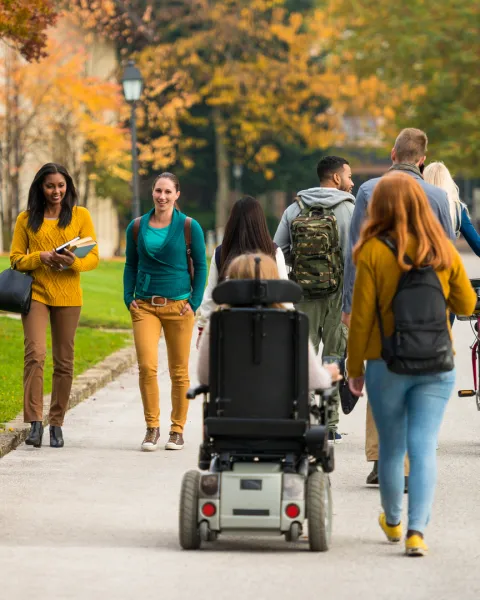Takeaways
- The Court determined that student ADA and Rehabilitation Act claims should be subject to the same standards as in other settings and rejected a higher “bad faith or gross misjudgment” standard.
- The decision leaves open the question of what those standards are.
- Educational institutions may need to adjust their accommodation policies and risk assessments going forward.
Related link
• A. J. T. v. Osseo Area Schools (opinion)
Article
On June 12, 2025, the U.S. Supreme Court issued a unanimous opinion in A. J. T. v. Osseo Area Schools, No. 24-249, holding that discrimination claims brought under Section 504 of the Rehabilitation Act of 1973 and Title II of the Americans with Disabilities Act (ADA) in the educational setting should be subject to the same standards as such claims brought under these statutes in other contexts. The Court left open what the proper standards under the ADA and Rehabilitation Act are, however.
Background
Many federal laws protect children with disabilities in public schools. They include the ADA, the Rehabilitation Act, and the Individuals with Disabilities Education Act (IDEA). The ADA and the Rehabilitation Act apply to disability discrimination claims in various contexts. The IDEA applies only in the educational context.
The plaintiff, A.J.T., was a teenager with a rare form of epilepsy that limited her physical and cognitive functioning. She suffered seizures that affected her ability to attend school before noon. Initially, her school provided A.J.T. accommodations that permitted her to start and end her school day later, which allowed her to receive the same hours of instruction as nondisabled students. However, after her parents moved, her new school district refused to provide evening instruction, thereby reducing her overall instruction hours.
A.J.T.’s parents filed an IDEA complaint with the Minnesota Department of Education, alleging the district’s denial of afterhours instruction denied A.J.T. a free and appropriate public education. An administrative law judge agreed and ordered various remedies, including at-home evening instruction. The school district sought judicial review, and the federal District Court of Minnesota affirmed the decision.
A.J.T.’s parents then sued the school district and Osseo School Board in federal court, alleging violations of the ADA and Rehabilitation Act and requesting a permanent injunction, reimbursement of certain costs, and compensatory damages. The district court granted summary judgment in favor of the school district and school board, finding that when alleged ADA and Rehabilitation Act violations occur in the educational setting, a school district’s simple failure to provide a reasonable accommodation is not enough to trigger liability. Rather, plaintiffs must establish the school acted with either “bad faith or gross misjudgment.” The U.S. Court of Appeals for the Eighth Circuit affirmed the decision.
Supreme Court’s Decision
The Supreme Court reversed and remanded the case, holding that the standard of proof to establish claims based on educational services under the ADA or Rehabilitation Act should be the same as the standards that apply under these laws in other contexts. The parties did not dispute this particular issue. The Supreme Court refused to address the further issue raised by the school district over what the standards should be and whether they should be the same regardless of whether the plaintiff was seeking damages or an injunction. These issues were not properly raised below and were not properly before the Supreme Court.
The concurring opinions between Justices Clarence Thomas and Brett Kavanaugh, on one hand, and Justices Sonia Sotomayor and Ketanji Brown Jackson, on the other, suggest that what the proper standards should be in disability discrimination cases is far from decided.
What Should Schools Do?
The Supreme Court rejected the school district’s request that a bad faith or gross misjudgment standard be applied in ADA and Rehabilitation Act cases. A number of circuits, in addition to the Eighth Circuit, had applied this standard in the school setting. Although the Supreme Court left open what the proper standards under the ADA and Rehabilitation Act are, courts clearly cannot apply a different standard for claims in the school setting.
Schools that relied on the bad faith or gross misjudgment standard when making their decisions or assessing their risk, may need to readjust. Schools face numerous accommodation requests. Responding to these requests in good faith may not always suffice. Although we expect to see further litigation on what the correct standard should be for claims under the ADA and Rehabilitation Act, schools and others subject to these laws should reevaluate their accommodation policies, procedures, and litigation risk analyses in light of this decision.
© Jackson Lewis P.C. This material is provided for informational purposes only. It is not intended to constitute legal advice nor does it create a client-lawyer relationship between Jackson Lewis and any recipient. Recipients should consult with counsel before taking any actions based on the information contained within this material. This material may be considered attorney advertising in some jurisdictions. Prior results do not guarantee a similar outcome.
Focused on employment and labor law since 1958, Jackson Lewis P.C.’s 1,100+ attorneys located in major cities nationwide consistently identify and respond to new ways workplace law intersects business. We help employers develop proactive strategies, strong policies and business-oriented solutions to cultivate high-functioning workforces that are engaged and stable, and share our clients’ goals to emphasize belonging and respect for the contributions of every employee. For more information, visit https://www.jacksonlewis.com.



